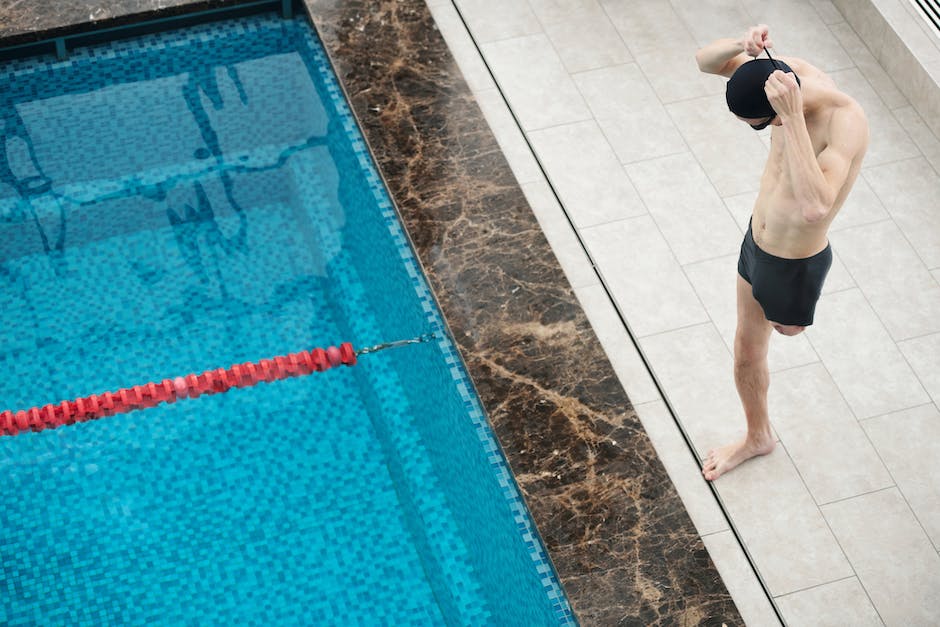
Discovering the Fitness Benefits of Swimming
Swimming is a great way to stay fit and healthy, and many people are starting to realize the amazing benefits it offers. From increased cardiovascular endurance to feeling more energized, swimming can be a great way to get in shape and stay healthy. In this article, we will explore the many fitness benefits of swimming that you might not be aware of yet.
List of Content
- 1. Why You Should Try Swimming for Fitness
- 2. The Exercise Physiology of Swimming
- 3. Muscle Groups Targeted by Swimming
- 4. Swimming Workouts to Increase Strength
- 5. Cardiorespiratory Benefits of Swimming
- 6. Taking Control of Your Swimming Regimen
- You Ask, I answer

1. Why You Should Try Swimming for Fitness
Swimming is an excellent form of exercise for anyone looking to get fit and stay healthy. Not only does it provide an excellent source of cardiovascular activity, but it’s also low-impact, meaning it’s easy on your joints. Here are some reasons you should try swimming for fitness:
- It’s an effective full-body workout. Because your body is supported by water, you’re able to get an effective workout without putting too much strain on your joints. Swimming exercises your arms, legs, and core, making it a great cross-training activity.
- It burns a lot of calories. Swimming for just 30 minutes can burn as many calories as a 5-mile jog. If you’re looking to lose weight, swimming can help you get there faster.
- It’s good for your heart. Swimming increases cardiovascular endurance, keeping your heart and lungs healthy. It can also lower your blood pressure, which can decrease your risk of developing heart disease.
- It can help reduce stress. Swimming can be an excellent way to de-stress and relax after a long day. The rhythmic movements, combined with the calming effects of being in the water, can help you relax your mind and let go of any tension.
Swimming is an excellent way to get fit and stay healthy. It provides an effective full-body workout that burns a lot of calories and is great for your heart. Plus, it can help reduce stress and is low-impact, meaning it’s easy on your joints. So get out there and give it a try!

2. The Exercise Physiology of Swimming
Swimming is a great full-body workout that doesn’t put too much strain on your joints. It enables you to strengthen your heart and lungs, as well as your bones and muscles. It works both your upper and lower body, and it can help you lose weight, build power and gain endurance.
Swimming puts minimal pressure on your bones and joints thanks to its low-impact nature. The natural buoyancy of the water works to reduce any sudden movements while swimming, meaning you won’t feel too much strain despite your motions. You can swim for long periods of time that would otherwise compromise other forms of exercise.
Your lungs benefit from swimming because of the large amounts of air needed in order to generate enough power to keep propelling you forward. This is especially interesting for those who struggle with pulmonary diseases as it promotes breathing health. Additionally, it also gives your heart a great cardio workout as it helps to increase blood flow.
Finally, swimming also has its benefits for your bones and muscles. It helps build muscle structure and endurance through different techniques. This leads to a much stronger body overall, especially in your arms, legs, and core.
- Low-impact exercise: Unlike other forms of exercise, swimming allows you to get a great workout without putting hefty amounts of pressure on your joints.
- Lungs and heart: Swimming is known to help strengthen these organs, which is especially great for people with pulmonary diseases.
- Muscles: Swimming helps you to build muscle strength and endurance throughout your body.
3. Muscle Groups Targeted by Swimming
Swimming is an excellent aerobic and resistance exercise that can help strengthen different areas of the body, from the core to the extremities. Whether your goal is to become a better athlete or just to keep fit, this sport can help you achieve it! Here are the main .
Upper Body. The shoulders, arms and back muscles are heavily used while the breaststroke and butterfly techniques are performed, especially for the back muscles. The upper body must produce the greatest force to move forward in the water.
Core. Swimming works the entire core area of the body, from the abs to the lower back. The core muscles provide stability while swimming and are used in coordination with the arms and legs. A strong core is essential for successful performance and also for preventing injuries.
Legs. The legs, especially the glutes, quads and calves, are worked heavily during the freestyle and backstroke techniques. The legs are pushed down and back while you kick, pushing you forward in the water.
- The muscles of the upper body, such as the shoulders, arms and back, are specifically worked during the breaststroke and butterfly techniques.
- The core muscles must be strong in order to maintain body stability while swimming.
- The legs, glutes, quads and calves, are used to push forward while you kick in the water.
4. Swimming Workouts to Increase Strength
Strength training is essential to improve performance in swimming. Here are four swim workouts that will help build strength.
Swim Intervals: Swim intervals are just what they sound like – swim a designated distance (like 25 meters or 50 meters) at a fast pace, then rest for a few seconds before repeating. To increase strength, make sure the intervals are challenging. You want to swim at a pace that you can barely make it through the distance before the allotted rest time is up.
Weighted Pull-ups: Add a bit of resistance to your pull-up game! Use a weight belt to add a few extra pounds to your pull-ups. The additional weight will make it harder to pull yourself up, forcing your muscles to work even harder.
Free Weights: Take a break from the pool and hit the gym. Lift free weights like dumbbells and barbells while standing or sitting on a weight bench. Focus on exercises that work the shoulders, back, and arms. This is an excellent way to supplement your swimming training while strengthening the key muscles necessary for efficient swimming.
Underwater Workouts: Resistance training in the pool can add an extra challenge. Try exercises like underwater push-ups and squats that offer additional resistance thanks to the push-back from the water. These exercises not only increase strength but also improve body control and balance.
5. Cardiorespiratory Benefits of Swimming
Exercise Intensity
Swimming is an aerobic exercise, as it relies on oxygen to fuel the body. When swimming, you will be providing your body with an increased supply of oxygen, resulting in a greater calorie burn. The intensity of your swim workout will depend on the type of stroke you are performing, along with the swimming speed and resistance of the water.
Improves Cardiorespiratory Fitness
Swimming is excellent for improving cardiorespiratory fitness. Research has demonstrated that it is a vigorous exercise, requiring the oxygen consumption rates of about 34-60 percent to the maximum of a person’s oxygen consumption capabilities. In addition, swimming engages both the upper and the lower body for a full body workout, thus pushing the heart and lungs to their maximum potential and giving long-term health benefits. As your body becomes used to swimming, you will find yourself tired less easily, and able to swim for longer periods and at faster speeds.
Strengthens Muscles
Swimming is also beneficial in strengthening muscles. Depending on the type of stroke, certain muscles are more engaged when swimming than during other forms of exercise. The butterfly stroke requires stronger arm muscles, while breaststroke places more focus on the legs. As you become stronger, you can do longer and more rigorous sets of swims.
Enhanced Flexibility and Relaxation6. Taking Control of Your Swimming Regimen
Being able to manage and take control of your swimming regimen is an important part of becoming more comfortable and competent in the water, as well as having success in competitive swimming. Here are some helpful methods for :
- Aim for a Varied Regimen: Variety is a key to making steady progress and avoiding boredom when it comes to swimming and training. Aim for a balanced regimen, with alternative exercises, techniques or drills to focus on the development of different muscles and types of strokes. For the same reason, don’t always start at the same end of the pool – vary the swimming laps for added variety in your routine.
- Set Specific Goals: Setting specific goals is essential to having a successful swimming regimen. Start by focusing on simple objectives that are achievable, such as improving one’s technique or increasing speed. As you progress, make small increments to the goals, eventually leading to reaching one’s long-term goals.
- Pay Attention to Your Body: Listening to one’s body and knowing when to rest is just as important as training hard. Don’t be afraid to take breaks when you are feeling exhausted or over worked. Take a break and let your body recover so that you can resume with the same level of energy and focus.
- Stay Motivated: Staying motivated is necessary to maintaining a successful and productive swimming routine. Find a way to keep yourself motivated – this may mean having a partner to train with, a coach to check your progress, or tracking your progress with visual or statistical aids.
By implementing these methods for , you can improve your swimming skills and take your performance to the next level. With dedication to a balanced training regimen and focus on achieving goals, mastering the art of swimming is within reach.
It is also essential to stay safe, especially when swimming long distances and pushing your physical limits. Don’t be afraid to ask help if needed, as drowning is still one of the leading causes of accidental death. Follow safety rules and regulations, and make sure that you take regular breaks to stay safe.
You Ask, I answer
Q: What are the benefits of swimming as a form of exercise?
A: Swimming is an excellent form of exercise because it engages your entire body and simultaneously strengthens your muscles, cardiovascular system, and lungs. It is also known to improve coordination, balance, flexibility, and overall fitness level. It also has positive effects on mental health, including stress relief and improved sleep quality. Plus, it’s low impact, so it’s easy on your joints.
Q: Are there any drawbacks to using swimming as a workout?
A: While swimming has many advantages, one potential downside may be boredom. It’s important to mix up your routine to keep it interesting and prevent feeling burnt out. Additionally, keeping up with proper technique is essential to prevent injury. Finally, if you want to make the most of your time, swimming in a pool that has marked lanes for swimming laps would be ideal.
Q: What advice do you have for someone getting started with swimming?
A: Start slow and listen to your body – don’t overexert yourself. Make sure to use proper technique and consider investing in equipment such as goggles, a swim cap, foam swim fins, and a pull buoy if you plan on swimming regularly. Additionally, find a safe and clean swimming area and use common sense at all times. Lastly, it’s important to set realistic goals so you can reach your fitness objectives while still having fun!
Swimming is an incredible fitness activity that can help people of any age become more fit, healthy, and active. Plus, swimming can also be a fun and enjoyable pastime for the whole family. With all the benefits swimming provides, it’s clear that taking the plunge and diving into the water can have a tremendous impact on your overall wellbeing.


